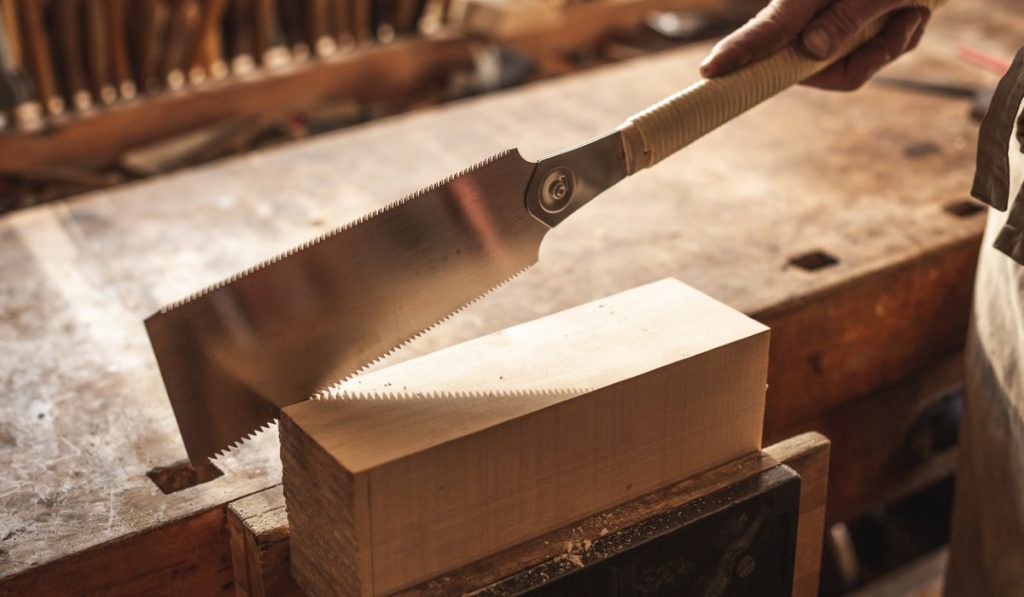Learn To Use a Japanese Pull Saw for Your DIY Projects

If you’re a DIY enthusiast, you’ve likely heard about the versatile and effective Japanese pull saw. These saws are smaller and much lighter than their Western counterparts, making them an ideal choice for a variety of projects. But, using a Japanese pull saw can take some getting used to if you’re not familiar with it.
In this post, we’ll explain everything you need to know to get started with a Japanese pull saw. We’ll cover the advantages and disadvantages of these saws, the different types available, and some tips and tricks to help you get the most out of your saw.
What Is a Japanese Pull Saw?
Pull Saws are lightweight hand saws that are designed for precision cutting with minimal effort. They have been used in Japan for centuries, but they have gained in popularity as more and more people become aware of their usefulness in DIY projects. There are two main types of Japanese pull saws, Ryoba and Kataba. Ryoba pull saws are dual-edged, meaning they have both a crosscut edge and a rip-cut edge on the same blade. Kataba pull saws only have one edge and are often considered the more precise of the two.
Types of Pull Saws
Ryoba pull saws are available in two common sizes: dozuki and shinogi. The dozuki is a medium-sized saw commonly used for detail work such as making joints or cutting intricate patterns. The shinogi is a bigger version of the dozuki, which is more suitable for larger tasks such as cutting boards or logs.
Kataba pull saws also come in two sizes: unokubito and senkubito. Unokubito saws are perfect for making bevel cuts, while senkubito saws can make straight cuts quickly and accurately. Both types of kataba pull saws can also cut through thick materials without getting stuck or binding up like most other manual saws.
Benefits of Pull Saws
One of the main advantages of using a Japanese pull saw is that it requires minimal effort while still providing clean, accurate cuts. This makes it ideal for detailed work like cutting fine patterns or making joints. Since it doesn’t require electricity or fuel to operate, it’s also environmentally friendly. It’s lightweight and easy to transport, so it’s great for people who are always on the go and need to bring their tools with them wherever they go.
Using a Japanese Pull Saw
Selecting a Blade
Before you begin using your Japanese pull saw, there are some things you need to prepare first, such as selecting an appropriate blade based on the material you plan on cutting and setting up the handle correctly. When selecting a blade for your Japanese pull saw, consider what type of material you plan on cutting so that you get one that’s suited for the job at hand. Different blades will perform better on different materials.
Setting up the Blade and Handle
Once you’ve selected an appropriate blade size based on the type of material you’ll be cutting, you’ll need to attach it securely between the handle guard brackets so that it won’t become loose during use. This usually involves inserting screws in each hole before tightening them down with an Allen wrench. You’ll also want to make sure the handle has been properly adjusted so that it fits comfortably in your hand before beginning any cuts.
Safety Considerations
As with any tool, safety should be taken into account when working with a Japanese saw. It’s important to wear protective gear such as goggles or a dust mask whenever you’re using it to protect your eyes and lungs from dust particles or splinters that may be created during use. Keep your hands away from the blade while cutting to avoid unnecessary injuries.
Cutting Techniques
Now that your Japanese pull saw is properly set up, you can begin making cuts. Some techniques should be used to ensure a successful cut.
Proper Blade Angle
The angle at which you hold your Japanese pull saw when making cuts is important if you want accurate results. Typically this angle should be around 30 degrees, although this may vary depending on what type of material you’re attempting to cut through. If you’re unsure, just test out different angles until you find one that works best. Make sure all four corners of your blade remain supported throughout each cut so that no part gets stuck or damaged throughout use.
Applying Pressure
When applying pressure during each cut line, it needs to be even throughout. Don’t start strong only to let up at some point during the process. Also, make sure that you do not overdo it since this could throw you off balance, which could result in an unexpected accident.
Conclusion
If you’re a new woodworker or you’ve been doing this for a while, a Japanese pull saw will make a great addition to your workshop. It does take some getting used to, but once you learn how to use it, you will be amazed by the results.
